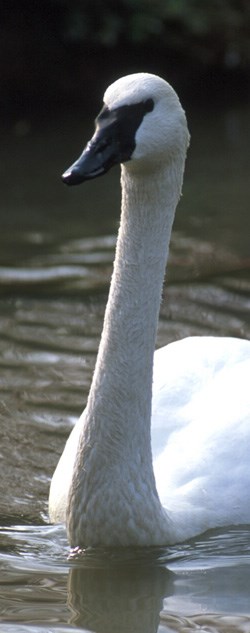NEWS RELEASE
MICHIGAN DEPARTMENT OF NATURAL RESOURCES
************************** DNRE requests trumpeter swan observations from the public
The Department of Natural Resources and Environment is asking the public to report any observations of trumpeter swans for a continent-wide census that the DNRE is participating in to determine the population size and distribution of the birds.
“To obtain the best coverage, we are asking the public to report observations of these birds during August and September,” said Christopher Hoving, endangered species coordinator with the DNRE's wildlife division.
The trumpeter swan’s recovery represents another success in endangered species recovery.
Historically, trumpeter swans nested in wetlands across much of the continental United States, including Michigan.
By 1885, unregulated shooting and wetland destruction had eliminated the population from the state.
By 1900, the species was considered extinct.
Decades later, two previously unknown populations were discovered in the Rocky Mountains and Alaska.
Efforts to restore the species to Michigan began in the late 1980s.
In 1989, 1990 and 1991, trumpeter swan eggs were collected from pairs maintained by zoos and from wild pairs in Alaska.
The eggs were hatched and young were reared in captivity for two years at the Michigan State University Kellogg Biological Station.
Initial releases in Michigan occurred at Seney National Wildlife Refuge, Rifle River Recreation Area and MSU Kellogg Bird Sanctuary.
In 1992, released birds began to nest successfully and rear offspring, representing the first natural reproduction of the species in Michigan in more than 100 years.
Since then, additional birds have been released and the population has grown dramatically.
In 2004, 655 trumpeter swans were counted during the late-summer survey.
The highest concentration of the birds can be found in the eastern Upper Peninsula (UP), with additional groups found in the Northeastern Lower Peninsula (NLP) and Southwestern Lower Peninsula (SLP).
Trumpeter swans now occur in other areas, including Gogebic and Ontonagon counties in the Western UP, Manistee and Mason counties in the NLP and Washtenaw County in the SLP.
“With oil spills and invasive species like Asian carp and feral swine threatening Michigan wildlife, I sometimes feel discouraged,” said Tom Funke, director of conservation for the Michigan Audubon Society. “Then I remember that the trumpeter swan was gone from Michigan for 100 years, and yet their song can again be heard over Michigan waters. That gives me hope.”
Although the population is doing well, the trumpeter swan remains protected as a state threatened species, due to the young age of the population and its somewhat limited distribution within the state.
Both trumpeter swans and mute swans occur in Michigan.
Mute swans, which are not native and can be quite aggressive as well as destructive to wetland systems, will not be counted.
Citizens making trumpeter swan reports should familiarize themselves with the differences between the two species:
Bill and head
Trumpeters have a black bill with a thin red line on the upper edge of the lower bill, and the head is wedge-shaped.
Mute swans have a bright orange bill and a distinctive black knob on the forehead.
Neck shape
Trumpeter swan necks are kinked at the base and often form a ‘C’ curve.
Mute swans tend to hold their necks in an ‘S’ curve with their bills pointing down.
Voice/ call
Trumpeter swans have a loud, resonant, trumpet-like call.
Mutes are generally silent but can issue a variety of grunts, snorts and whistles.
Photos and additional information on trumpeter and mute swans can be found on the DNRE website at www.michigan.gov/dnre.
Observers should submit reports online at www.michigan.gov/wildlife under Report Wildlife Observations or by calling 517-373-1263.
Those submitting reports should be prepared to provide the specific location and date of observation.
Information on single swans, pairs, pairs with young and flocks with three or more swans will be useful.
Only observations made after Aug. 15 should be reported.
“More people have participated in each survey,” said Hoving. “Michigan citizens need to act fast because this opportunity only comes every five years.”
This project is being funded by the Nongame Wildlife Fund which is supported by citizen contributions.
You can support additional work for endangered and threatened wildlife in Michigan through purchase of a “Critical Wildlife Conservation” vehicle registration plate or through a direct contribution to the Nongame Wildlife Fund by sending a check to:
Natural heritage unit, wildlife division Michigan Department of Natural Resources and Environment P.O. Box 30444 Lansing, MI 48909
The Department of Natural Resources and Environment is committed to the conservation, protection, management, accessible use and enjoyment of the state’s environment, natural resources and related economic interests for current and future generations.
Learn more at www.michgan.gov/dnre.
**************************
